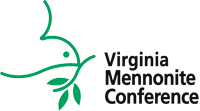
Hope in a time of change
by Clyde G. Kratz
Executive Conference Minister
Virginia Mennonite Conference is a network of congregations and organizations seeking to live out God’s mission in the world.
Our congregations are located in rural and urban settings. Our membership holds diverse views on a range of theological issues and concerns about society. While we are historically a peace church, we have not always known how to achieve unity in relationship with each other over the issues that tend to divide us. At times our focus is on what divides us rather than what unites us. This is the Church in which we are participants, sometimes actively and sometimes passively.
John Roth wrote an essay “The Church “Without Spot or Wrinkle” in Anabaptist Experience.[1] His essay was presented at Anabaptist Mennonite Biblical Seminary in February 2000, in the midst of the discussions on the integration of the Mennonite Church and the General Conference Mennonite Church. He highlighted two central themes:
1. The principle and practice of church discipline has been foundational to a distinctive Anabaptist-Mennonite understanding of the church;
2. For virtually all of our 475 year history, the teaching and practices regarding church discipline have been a source of profound disagreements, intense conflicts, and numerous schisms within the Anabaptist/Mennonite Church. He resolved that we needed to embrace both discipline and conflict.
Virginia Mennonite Conference has been navigating a period of time where Conference leadership has exercised discipline. Leaders have not rushed into disciplinary processes, but engaged the disciplinary processes with hope to achieve clarity about conviction and expected behaviors of credentialed leaders.
As the Faith and Life Commission engaged disciplinary processes, new patterns of conducting investigations of credentialed leaders and lay leaders began to emerge from Mennonite Church USA. There has been uneasiness within our Conference concerning best practices for conducting an investigation into ministerial misconduct.
Each district of our conference has been invited to review and respond to “Navigating Ministerial Complaints.” This process provides an opportunity for leadership discernment and transparency concerning protocols and policies for disciplinary matters of credentialed leaders.
While policies and protocols are necessary for our life together, preventive education is also essential for credentialed leaders. Virginia Mennonite Conference partnered with FaithTrust Institute to equip Lonnie and Teresa Yoder to be trainers within our Conference on Healthy Boundaries, a form of ethical training for credentialed leaders. The Faith and Life Commission is requiring this training for all active credentialed leaders with a time frame for completion. In addition all newly credentialed leaders will be given a year to conclude the training. In the future Faith and Life Commission will be looking at additional ethical training frameworks for active credentialed ministers.
Conflict is not new to our life together. As we navigate conflictual circumstances, it remains my hope to challenge us and to be challenged about leadership processes that may help us find a resting place with the issues that contribute to the conflict.
I have intentionally utilized the language of “resting place” because some of the conflicts that I am aware of will not be solved as a win-lose scenario or the final solution. At best, the leadership direction is to find a space that we can talk with each other without forcing each other to embrace our view, but be able to live and learn from each other in the future.
I have appreciated reading Re-imagining The Church: Implications of Being a People In the World by Robert J. Suderman. A takeaway from my reading is that merely redirecting our focus upon mission will not solve our problems.
A missional vision is deeply concerned with expanding the breadth of influence of the people of God in the world, but it is also interested in the scope of challenge that exists within the framework of the people of God. Being a disciple with a missional vision responds to the subject matter that our worshippers and the community in which we reside are grappling over. Their concerns and issues demand our attention from a faith perspective.
A major leadership initiative that is underway is Restructuring for Mission. This task force is looking at how the people of God conduct their communal life as a network of congregations.
I am excited by the way in which the group is seeking to simplify our structure and limit administrative work for districts and conference. Our goal is to generate an effect leadership model that can serve congregations and credentialed leaders in a way that supports and strengthens their missions.
This is not an easy task as old patterns of organization are reconfigured. Our leadership culture, both credential leaders and lay leaders, value the way in which much of our structure has provided stability and predictability. As new patterns emerge, there will need to be acknowledgement that these changes will not be without angst, emotional frustration, and resistance.
The changes that are coming are seen as helping us sustain our Conference into the next decade.
As we look forward, it remains my hope to continue providing leadership to Virginia Mennonite Conference, as we make disciples, discern difficult issues, and revitalize our life together by reshaping the structures that hold us together. It is a missional vision of being the body of Christ.
1 The essay by John Roth is the first chapter in the book Without Spot or Wrinkle: Reflecting Theologically on the Nature of the Church, published by WIPF and Stock, Oregon, 2015.
